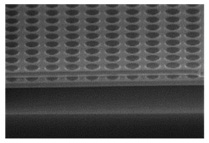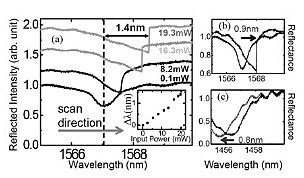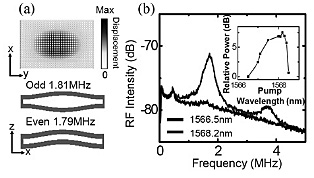Eiichi Kuramochi, Shinji Matsuo*, Tomonari Sato*, and Masaya Notomi
Optical Science Laboratory, *NTT Photonics Laboratories
Mechanical interaction between light and matter is one of the most fundamental
problems in physics. Recently, coupling phenomena between optical and mechanical
resonant modes in photonic structures has attracted strong interests. In
2006, our group theoretically predicted that a bi-layer photonic crystal
(PhC) with a thin air gap can generate strong radiation force [1]. In this
work, we have realized a bi-layer PhC for the first time and have demonstrated
strong optomechanical coupling in it [2].
A periodic hole pattern arranged in a square lattice was fabricated in
two vertically separated slabs using electron beam lithography, dry-wet
etching, and CO2 supercritical drying (Fig. 1). The period, hole diameter, slab thickness,
and gap thickness are 750 nm, 540 nm, 200 nm, and 200 nm, respectively.
We performed reflectance spectrum measurements of the bi-layer PhC formed
in the lateral area of 30×20 µm, which revealed photonic bandedge
resonant modes around 1567 nm and 1457 nm. These modes exhibit opposite
mode symmetry along the vertical direction. Figure 2 shows reflectance
spectra obtained by wavelength scan around symmetric mode (1567 nm), which
exhibit input power dependence and optical bistability. We concluded that
the observed redshift is explained by a slab displacement (i.e. gap decrease)
induced by attractive radiation force for the symmetric resonant mode.
The thermo-optically induced shift is excluded because we observed opposite
blueshift for the antisymmetric mode (1457 nm). We estimated that each
slab was displaced by 0.9 nm at Pin=13 mW when the redshift was 1.8 nm. This corresponds to attractive force
of 10.8 nN, and thus F/U (i.e. generated force per unit energy in cavity)
can be estimated 0.4 µN/pJ, which is a very large value among various
optomechanical systems. Thanks to this large optomechanical coupling, we
have successfully observed tiny Brownian motion of mechanical modes of
bi-layer PhCs [shown in Fig. 3(a)] in RF spectra of the reflected light
beam [Fig. 3(b)].
[1] M. Notomi et al., Phys. Rev. Lett. 97 (2006) 023903.
[2] Y. Roh et al., Phys. Rev. B 81 (2010) 121101(R).
 |
|
 |
 |
|||||
|
|